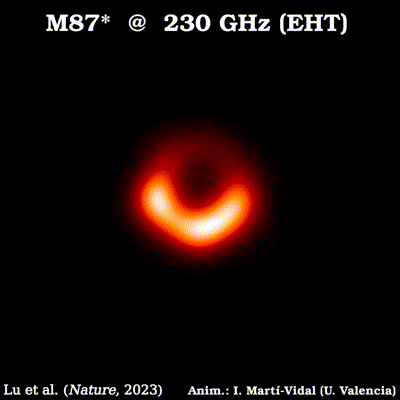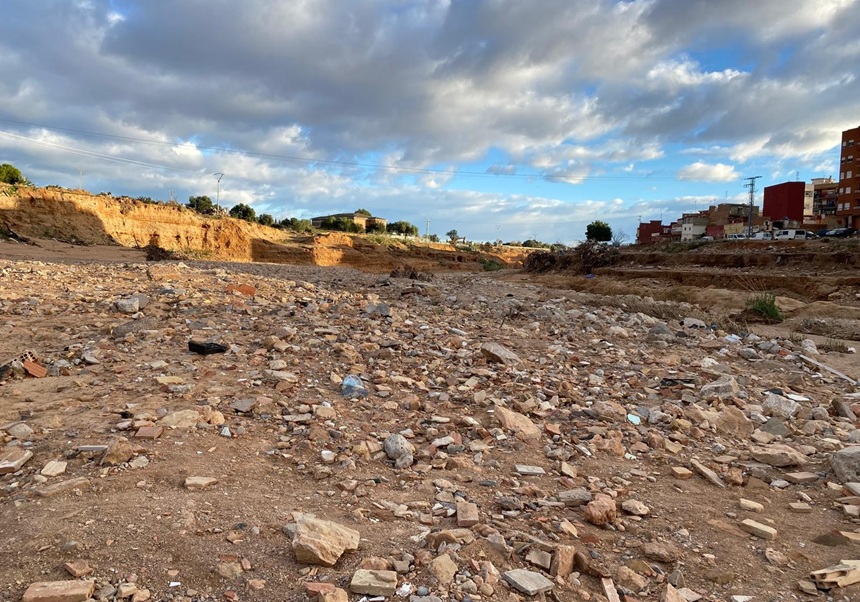New image of M87 black hole reveals the source of powerful particle jet emanating from its shadow
- Press Office
- April 26th, 2023

An international scientific team, along with the participation of the Yebes Observatory (IGN-MITMA) and the University of Valencia, have obtained new data that show the first unedited view of the famous M87 black hole, whose first image was published by the Event Horizon Telescope (EHT) in 2019. This time, the data shows not only the central shadow, but also the origin of the jet of charged particles emanating from this region at speeds close to the speed of light.
The new observations, obtained with the Global Millimetre VLBI Array (GMVA), the Atacama Large mm/submm Array (ALMA), and the new Greenland Telescope (GLT), show how this charged jet was formed from the material falling into the supermassive black hole at the heart of M87. The results are published in the current issue of the journal Nature.
“Until now, we only had separate images of the central black hole and its jet,” states Ru-Sen Lu, lead investigator of the study at the Shanghai Astronomical Observatory. “However, this time around we managed to secure an image of the entire system with enough clarity to finally see the nexus between the black hole and the jet.”
The new image, with a sharpness that would make it possible to distinguish a football from the moon, provides remarkable information about this black hole. For example, it has been deduced that the rate at which the black hole is devouring materials from the surrounding disk, is actually quite low. Moreover, the shape of the jet right at its nexus with the black hole is wider than expected according to the current available models of General Relativity. “We could be seeing the effects of plasma winds in the vicinity, which would distort the jet and affect its propagation,” explains Iván Martí-Vidal, professor of the Astronomy and Astrophysics Department at the University of Valencia and co-author of the project. However, more observation will be necessary to definitively put this hypothesis to test.
The Spanish contribution to this project has been fundamental, both in terms of instrumentation and algorithms. On the one hand, “with the Yebes radio telescope, one of the biggest of the GMVA, we have managed to help make noteworthy improvements in the clarity and reliability of these types of observations,” notes Pablo de Vicente, director of the Yebes Observatory (IGN-MITMA), also involved in the finding.
Also contributing to these observations is the Spanish-French-German 30 metre radio telescope from the Institute for Millimetre Radio Astronomy in the Granada Province of which the National Geographic Institute is a member. This radio telescope, like the 40m radio telescope, is a regular member of the GMVA network and has been vital in obtaining these results.
On the other hand, “the ALMA and GLT telescopes were also crucial in attaining this image, and thanks to the algorithms developed by the University of Valencia, we were fully able to use all of this data,” Iván Martí-Vidal specifies.
The new image of M87 represents a major breakthrough in our understanding of supermassive black holes, one of the most alluring mysteries of our known universe. “In the near future, it could be possible to make observations at different frequencies simultaneously, which would allow us to study black holes of similar sizes, but located at much greater distances than that of M87,” adds Javier González, engineer at the Yebes Observatory and co-signer on the project. “The best is yet to come.”
------------
VISUAL MATERIAL:
https://www.uv.es/imarvi2/outreach/M87_AllScales_v0_esp.jpg
Credit: I. Marti-Vidal. The M87 region at varying scales: from millions of light years (the Virgo Cluster) to a few light days (the central region of the black hole).
https://www.uv.es/imarvi2/outreach/M87_science_image_noText.jpeg
Caption: Image of the central shadow, the accretion disk, and the M87 black hole jet, obtained by the GMVA network.
https://www.uv.es/imarvi2/outreach/M87_GMVA_ESP.mp4
Credit: I. Marti-Vidal. Images of M87 taken with the EHT (orange) and the GMVA (green), showing the ring of light with a central shadow, the accretion disk, and the relativistic jet.
Categories: Astronomía i Astrofísica , Internacionalització recerca
















